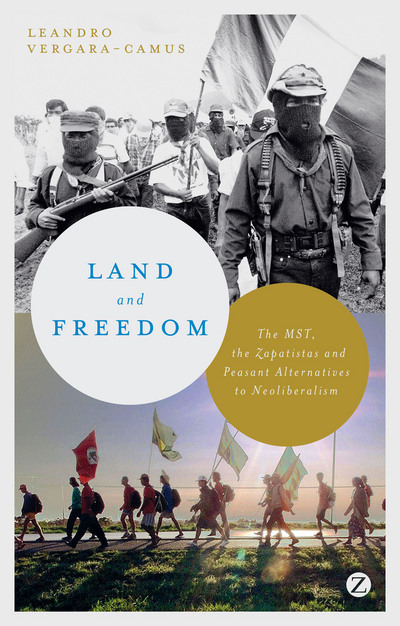The fieldwork experiences and interviews in Land and Freedom aim to provide a unique view of the internal dynamics of revolutionary movements in Brazil and Mexico. Readers interested in learning about these social dynamics and understanding how movements work will certainly benefit from this text, writes Francesco Di Bernardo. Details of the International Conference on Democracy and Participation in Latin America, on 19-21 March 2015 at the University of Sussex, are at the foot of this review.

Find this book: ![]()
Leandro Vergara-Camus’s new book provides a unique comparative analysis of two movements which have challenged the hegemonic discourse of the globalization project and the neoliberal policies implemented to actuate it: the Movimento dos Trabalhadores Rurais Sem Terra (MST, Landless Rural Workers Movement) in Brazil, and the Ejército Zapatista de Liberación Nacional (EZLN, National Liberation Zapatista Army) in Mexico.
MST and EZLN differ in social, cultural and ethnic context, geographical settings, and economic and historical background, but they are nonetheless united by the aims of building peasant fronts against neoliberalism and reclaiming the right to the land. For unfamiliar readers, MST officially became a national movement in 1984 in Cascavel, Paraná towards the end of the military junta which had overthrown the democratically elected president João Goulart in 1964. It was founded to coordinate grassroots movements working on land occupations. EZLN made their first appearance in January 1994 in the state of Chiapas, when they issued their first declaration. The trigger of their insurgence was the NAFTA agreement which the Mexican state signed with USA and Canada, de facto introducing neoliberal restructuring which penalised peasant and indigenous greatly.
MST and EZLN are among the social movements which stand out ‘for the radicalism of their challenge to the current neoliberal hegemony’ (p. 7), Vergara-Camus argues. Their initiatives, in fact, have had an impact on both local and national level and, moreover, have provided examples of alternatives to globalisation and free-market ideology, and have inspired several social movements in Latin America and gained wide academic attention. However, Vergara-Camus’s comparative study is distinctive because of the attempt to provide a broad analysis of how these movements differ from the previous struggle for land, and because it provides an understanding of their significance and relevance in the creation of a global radical alternative to neoliberalism.
In recent times, radical thinkers interested in alternatives to neoliberalism have identified the political struggle in urban areas as examples of radical experiments and theorisation of alternatives to neoliberalism; this has happened particularly after the Arab Spring, the rise of Occupy and Indignados movements, and after the waves of protests in Turkey, Brazil, and more recently in Mexico. David Harvey’s Rebel Cities: From the Right to the City to the Urban Revolution (2013) and the works of Hardt and Negri are examples of this trend.
Vergara-Camus, however, draws attention to the rural movements and to their relevance for the development of a radical alternative to the logics of the market. The book, in fact, focusing on the social and political activities of these two movements, highlights how they have been able to effectively implement non-market-based economies and to organise community-life around participatory logics and practices.
The book’s theoretical framework conflates alternative development with post-development theories, and draws from Arturo Escobar who called for ‘an abandonment of the concept of development altogether and a focus instead on alternatives to development as represented by social movements’ (p. 14). The importance of post-development theories, the author explains, resides in the criticism of alternative development theories, which became gradually embedded into mainstream liberalism. According to these mainstream development theories ‘development is ultimately about individual or community integration into the market’ (p. 16). On the contrary, Vergara-Camus states, ‘the struggle for land of the MST and EZLN is fundamentally about challenging capitalist private property and reclaiming control over land’ (p. 19). Framing the analysis of the two movements in this theoretical background is fundamental, in order for the author to evaluate the radical potential of MST and EZLN.
Chapter 2 is dedicated to the crisis of peasant agriculture and to the effects on neoliberal policies on the living conditions of peasants following restructuring measures in the 1980s in Brazil and in Mexico in the 1990s. The chapter is particularly interesting because it explains to readers the historical and social composition of the movements: ‘In Brazil and Mexico, small and medium size producers, peasants, squatters and rural workers had to bear the costs of this restructuring’ (pp 67-68). Starting from this context, the author subsequently discusses the rise and composition of MST and EZLN: ‘[t]he first wave of Sem Terra were mainly land-poor peasants, landless peasants […] and landless rural workers’ (p. 77). The second wave is ‘made up of landless rural workers with no family history of land possession’ (p. 77). On the other hand, EZLN represents ‘a movement made up of subsistence indigenous peasants and their semi-proletarianized kin, who migrate temporarily to work in farms or ranches or cities of Chiapas’ (p. 78).
Chapter 3 is the chapter in which Vergara-Camus’s fieldwork experiences play a crucial role. Drawing from Gramsci’s theory of the Modern Prince and from on-field experiences, the author describes the organization of autonomous communities and the structure of the organization. Land and Freedom is, in fact, the result of years of fieldwork during which the author had witnessed the implementation of the theories of participatory decision-making and the practices adopted by these movements to reclaim the right to the land, and the creation of non-capitalist production. The author has talked to leaders and members at all levels of the organisations. The result is a ground-breaking study that dedicates space to the voices of dispossessed people directed involved in the movements and to their struggle. For example, Camus-Vergara interviews members of the two movements to ask about the participatory practices employed. A member of MST says:
Everyone goes to meetings […]. Everyone can speak, everyone speaks. If we have problems, there is the possibility of people helping to find a solution. That’s where problems get solved (p. 108).
Similarly the author interviews a member of the Comité Clandestino Revolucionario Indigéna-Comandancia General (Indigenous Revolutionary Clandestine Committee-General Command), part of the military structure of the EZLN, who explains how the committee if formed and the involvement of wider community in its structure:
The clandestine committee is chosen by the compas of all the communities. They are in contact with the bases de apoyo and they go around to collect the views of the compass [recogiendo la palabra]. (p. 118).
This part of the book based on fieldwork experience and interviews is particularly insightful because it provides a unique view of the actual dynamics inside the movements and their relations with the communities where they are active. Readers interested in learning about these social dynamics and understanding how the movements work on the territories can certainly benefit from the reports of these experiences within the movements.
Chapter 5 describes the ways in which the two movements engaged with other socio-political actors on a national level to create a broader front against neoliberalism, from MST’s early relations with the Partido dos Trabalhadores (Workers’ Party) to EZLN’s decision to sever links with any political parties, and the role of Subcomandante Marcos in the denunciation of the Mexican political party system.
Land and Freedom is fundamental for our understanding of the nature of these two movements. It is a book which not only provides detailed descriptions of the movements’ organisation based on fieldwork, but it is also very theoretically dense. It is recommended to academics and experts of development and Latin American studies and theorists of social movements, but also to those more broadly interested in critical thinking and radical alternatives to neoliberalism.
For those interested in issues related to Latin America, Sussex Latin America is hosting the International Conference on Democracy and Participation in Latin America, 19-21 March 2015, which will see the participation of academics, experts and students from all over the world.
Francesco Di Bernardo holds a PhD in Modern and Contemporary Literature, Culture and Thought from the University of Sussex. He is interested in the relationship between literature and history, economics, sociology and politics. He has completed a thesis focusing on the representation of British history from the seventies to the post 2007-2008 financial crisis in the works of Jonathan Coe and other contemporary British authors. He is Associate Tutor at the School of English of the University of Sussex and has worked as Research Support Assistant for the School of Media, Film and Music at Sussex. Read more reviews by Francesco.






